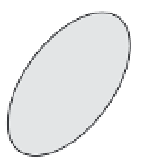Geology Reference
In-Depth Information
greater than 1-2 cm, measuring and reporting
geomorphic offsets with a resolution of 1-2 mm
suggests an accuracy that simply does not exist.
In this chapter, various geodetic approaches
are described, and examples of their applica-
tions are used to illustrate the types of positional
information that can be obtained with these
methods.
Near-field
techniques are those used
to examine deformation on the scale of meters
to a few tens of kilometers, whereas
far-field
techniques examine regional to global deforma-
tion fields. Simpler, traditional techniques of
surveying are often appropriate for near-field
observations and are described here first. Many
far-field measurements require more complex,
recently developed approaches and are
described in the second half of the chapter.
Several techniques, such as those using the
Global Positioning System, are used in both
near- and far-field applications.
10
12
Strain ≥ 10
-7
plate boundary
zone
tectonics
10
3 yr
OB
post-
glacial
rebound
10
10
post-seismic
rebound
10
8
Scales of
Geodesy
1 yr
strain
events
VLBI
10
6
EDM
1 day
creep
events
10
4
GPS
1 hr
volcanic
events
earthquakes
10
2
10
0
10
1
10
2
10
3
10
4
Spatial Scale (km)
Fig. 5.2
Spatial and temporal scales of geological
processes and various geodetic techniques.
Shaded ellipses depict typical ranges for classes of
processes. Cross-hatched boundaries indicate the present
range of various techniques for making geodetic
measurements. EDM: electronic distance meter; GPS:
Global Positioning System; OB: observation; VLBI:
very-long-baseline interferometry. Modified after Minster
et al
. (1990).
Near-field techniques
Styles of strain
The geometry of displacement that occurs along
a fault zone is strongly dependent on the
strength of the crustal material both within
the fault zone and on either side of it. Consider
the situation in which the fault zone is very
weak and is surrounded by strong rocks. Here,
it is likely that nearly all of the displacement
would be localized on the fault zone itself and
that the adjacent regions would be relatively
undeformed (Fig. 5.3A). Alternatively, if the fault
zone is relatively strong, then strain will tend to
be distributed across the terrain bounding the
fault, and no strong change in the displacement
gradient may be apparent as the fault is crossed
(Fig. 5.3B). Simple models of displacement
patterns (Fig. 5.4) clearly illustrate the influence
of rock strength or rigidity. For example, when
rocks bounding a fault have equivalent rigidi-
ties, a symmetrical pattern of strain is predicted
on either side of the fault. As the rigidity of one
side becomes increasingly high with respect to
the other, less and less strain will occur within
the more rigid block, and more will be focused
The spatial scales (Fig. 5.2) across which
geodetic measurements are collected vary from a
few meters - for example, during calibrations of
motion across a specific segment of an individual
fault - to thousands of kilometers - such as when
the relative motions of lithospheric plates are
calculated (Dixon, 1991; Minster
et al
., 1990).
Clearly, different geodetic tools are appropriate
for obtaining these highly varied scales of
measurements (Fig. 5.2). The choice of tool and
approach depends on both the scale of the
problem and the precision and accuracy required.
Based on the Global Positioning System (GPS)
and very-long-baseline interferometry (VLBI),
plate velocities can be calculated to
±
1-2 mm/yr.
This level of precision is unwarranted and is
perhaps misleading when describing offsets of
geomorphic features that have been displaced
due to faulting. Because geomorphic surfaces
typically have natural irregularities at scales of





































































